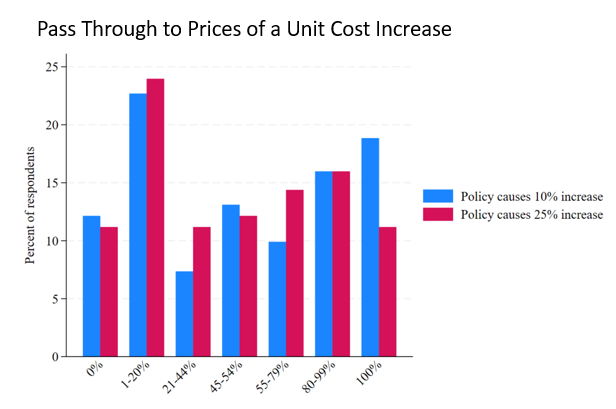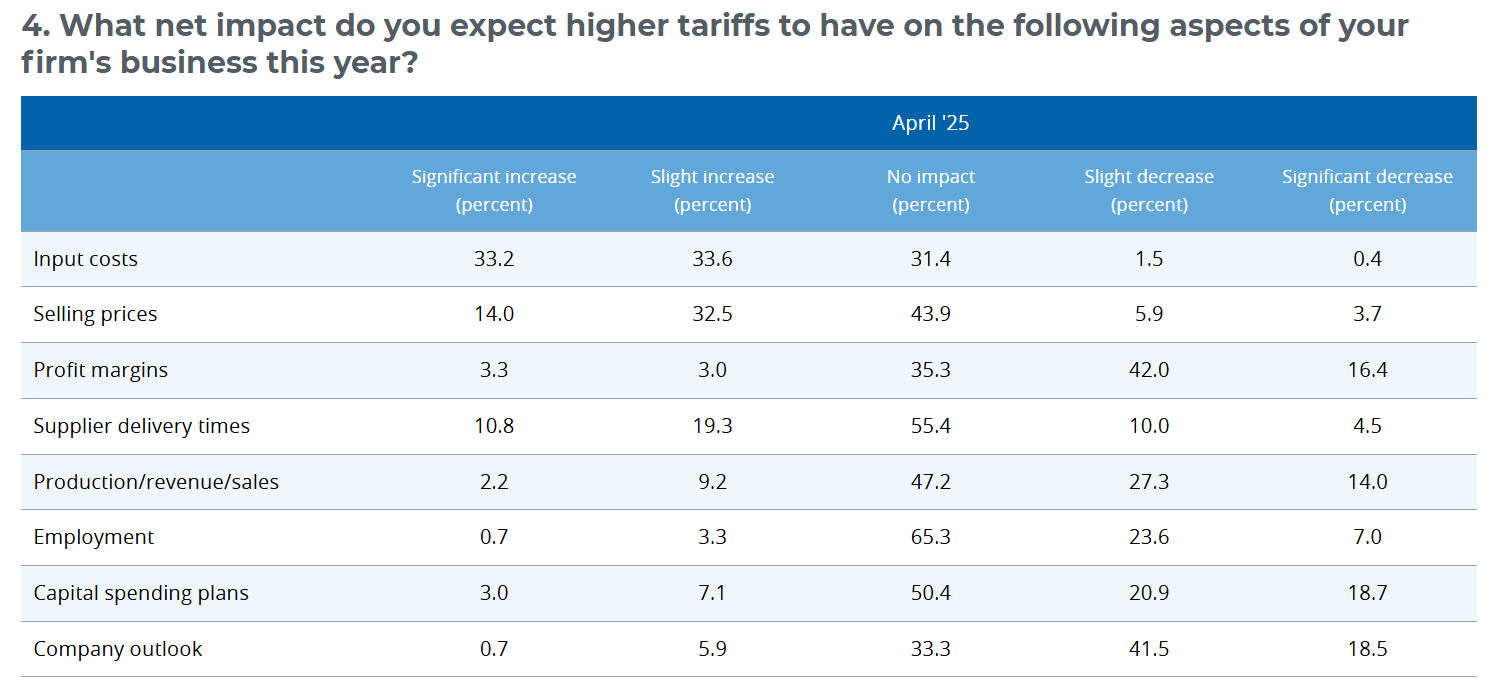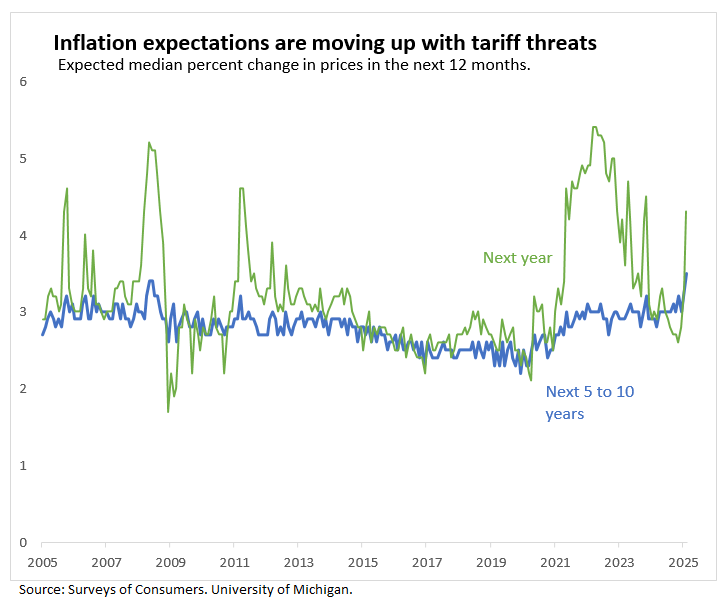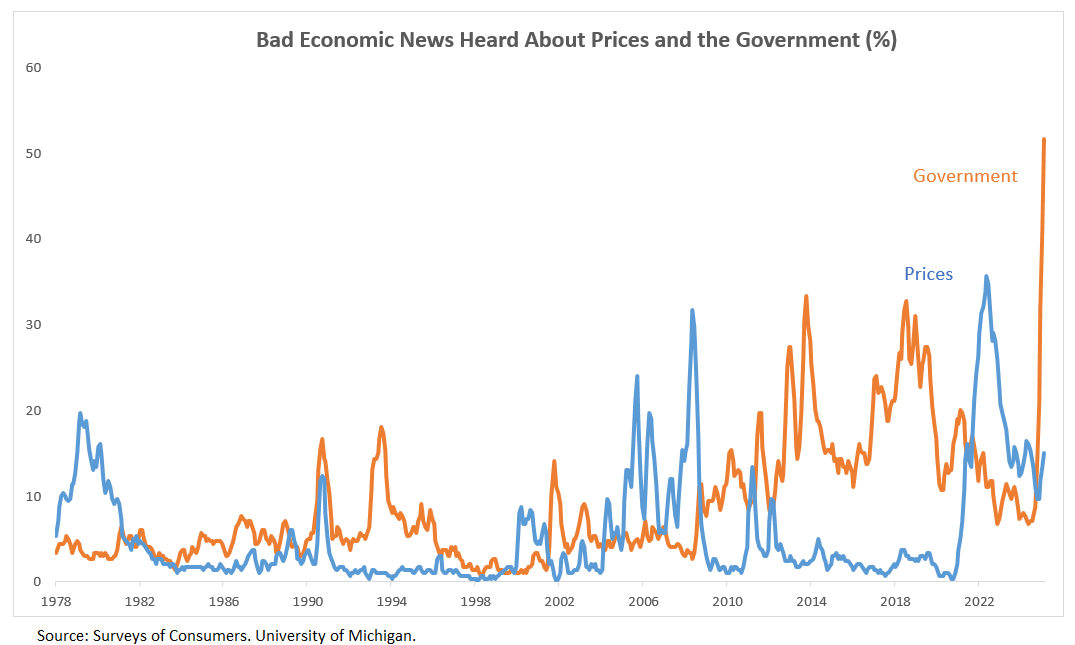The Fed will remain on hold today, keeping the federal funds rate in the range of 4.25% to 4.5%. It should continue to explain how it plans to assess and respond to likely changes in economic conditions. The potential tension in the dual mandate this year and heightened political criticism will make transparency in its decision-making more important than ever. A wait-and-see Fed must also be a ready-to-move Fed.
The so-called soft data, like consumer and business surveys, could be central to the Fed’s being nimble this year. Their flexibility and timeliness make soft data uniquely positioned to assess key questions like the persistence of tariff-induced inflation. Relying on inflation data alone might unnecessarily delay rate cuts to support employment or miss channels where persistence is building, leading to premature cuts. Being behind the curve—either on employment or inflation—would be costly.
Searching for Signs of Persistent Inflation
In his speech on April 16th, after 10% tariffs on most countries, some sectoral tariffs, and 145% tariffs on China had taken effect, Fed Chair Powell discussed the risk that tariffs could lead to persistently above-target inflation.
As we gain a better understanding of the policy changes, we will have a better sense of the implications for the economy, and hence for monetary policy. Tariffs are highly likely to generate at least a temporary rise in inflation. The inflationary effects could also be more persistent. Avoiding that outcome will depend on the size of the effects, on how long it takes for them to pass through fully to prices, and, ultimately, on keeping longer-term inflation expectations well anchored.
Soft data can be instrumental in assessing the likely persistence of tariff-induced inflation without waiting for hard data on the full inflation cycle, and it offers more empirical evidence than simply relying on the ‘textbook’ argument that tariff-induced inflation is temporary.
Size of the tariff-induced inflation effects
The magnitude of the tariff-induced inflation will depend foremost on the size and scope of the tariffs. The fact that the tariffs enacted in April were substantially larger than expected likely explains Powell’s heightened emphasis on the risk of persistent inflation.
While the White House has signaled that the tariffs on Chinese goods are unsustainably high and negotiations are set to begin this week, other potential sectoral tariffs on pharmaceuticals, semiconductors and electronics, lumber, and movies are under investigation.
Even so, the size of the tariffs does not translate one-for-one to consumer price inflation. The tariffs are a cost shock that is shared across several groups: businesses, shareholders, workers, and consumers. The ‘passthrough’ of tariffs to consumer prices is a key parameter that soft data can help shed light on.
The Atlanta Fed’s Business Inflation Expectations Survey in April asked how much of a hypothetical 10% and 25% cost shock businesses would pass through to their prices charged. (Note, the firms are a mix of business- and consumer-serving.) The wide range of responses is striking.
About one-third of firms would pass through less than 20% of a hypothetical cost increase to their customers’ prices, and nearly as many would pass through more than 80%.

Small firms reported lower pass-through rates than medium and large firms, while goods producers reported higher ones than service producers. Note that the survey asked all firms regardless of their exposure to tariffs.
In an alternate approach, the Dallas Fed outlook survey asked firms about the expected effects of the tariffs across several dimensions of adjustment. Two-thirds of firms expected higher input costs due to tariffs, and over 46% expected an increase in their selling price to their customers.
Noting that a “slight” increase was twice as likely as a “significant” one.
The survey covers other dimensions that businesses can adjust to the tariffs. Of note is that 65% of firms expect no effect of tariffs on their employment, versus 44% with no effect on their selling prices, and 35% with no effect on profit margins. Spreading the cost of tariffs across multiple dimensions would limit the size of the effect on any one outcome, like inflation.
Speed of the pass-through to prices.
The Fed’s latest Beige Book, which covered March through mid-April, offered insights on how quickly we will see the effect of tariffs on prices. Some businesses are positioning themselves to react quickly:
Expected passthrough rates were substantial, with half of manufacturers projecting a complete passthrough, mostly without lags. One manufacturer shortened the duration of its price quotes to 30 days in anticipation of the need to adjust prices rapidly (Boston Fed, emphasis added).
Several firms said that they recently raised their prices because their costs had increased as a result of tariffs. Many firms said that they were receiving letters from suppliers and sending letters to their customers warning that prices could increase in the near future due to tariffs. Several businesses said that until they had a better idea of how tariffs might impact them, they were minimizing new investments and planning for various cost scenarios. (Richmond Fed.)
A rapid adjustment in the level of prices would mean that the test of whether tariff-induced inflation is temporary would come relatively quickly. But even “relatively quickly” could mean several months for the full effect.
One retail industry analyst expected the price impacts of higher tariffs to largely be felt in the second half of the year and said retailers were expecting to pass about one-third of higher tariff costs on to consumers. (Chicago Fed.)
Research at the Fed using micro-level CPI data found that during the pandemic, the frequency at which businesses increased prices rose as overall inflation rose and then receded as inflation came down. Soft data can be a timely way to assess shifts in pricing behavior, and those shifts can inform more traditional forecasting models.
Inflation Expectations.
Inflation expectations are an area where the Fed’s use of soft data is well established, though it also monitors market-based measures of inflation compensation. Powell underscored the importance of inflation expectations:
Our obligation is to keep longer-term inflation expectations well anchored and to make certain that a one-time increase in the price level does not become an ongoing inflation problem.
Consumer and business surveys have seen a notable increase in the near-term inflation expectations for this year, but generally, the longer-term expectations have changed little. The Michigan Survey is an exception where the inflation expectations over five to ten years are also higher.

Powell has noted that the Michigan Survey is an outlier and characterized longer-term expectations as well-anchored. Digging into the Michigan Survey, it’s notable that this rise in inflation expectations is not accompanied by people reporting that they have heard bad news about inflation or actual inflation being higher. Instead, it’s accompanied by a surge in people hearing bad news about government policy.
Tariffs loom large in the survey. About 60% of respondents mentioned them specifically. The comments in other surveys, like the ISM or regional Fed surveys of businesses, are filled with mentions of tariffs. Note that the pessimism about tariffs stems from expecting their effects instead of witnessing them.
As the economic effects of the tariffs become more widespread, it will be important to watch how these survey expectations change. There is also evidence of partisan reactions to the tariffs, which present another filtering challenge for the Fed. The headline measures in the surveys may be noisier than usual, obscuring the true signal on expected inflation (the kind that might shape behavior).
Using other survey information or adding questions to the survey are ways to refine the interpretation.
In Closing
A data-driven Fed need not be a behind-the-curve Fed. It must draw on an even wider range of data to avoid that pitfall. Soft data can be especially important on the forward-looking question of whether tariff-induced inflation will be persistent. The Fed has a long history of monitoring—even producing—soft data. It would be helpful to communicate more explicitly how they fit into the Fed’s assessment of the economy and decision-making.
Which stock should you buy in your very next trade?
With valuations skyrocketing in 2024, many investors are uneasy putting more money into stocks. Unsure where to invest next? Get access to our proven portfolios and discover high-potential opportunities.
In 2024 alone, ProPicks AI identified 2 stocks that surged over 150%, 4 additional stocks that leaped over 30%, and 3 more that climbed over 25%. That's an impressive track record.
With portfolios tailored for Dow stocks, S&P stocks, Tech stocks, and Mid Cap stocks, you can explore various wealth-building strategies.
